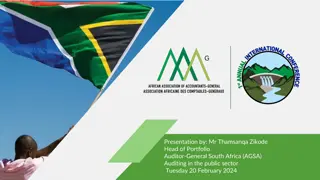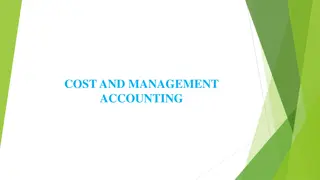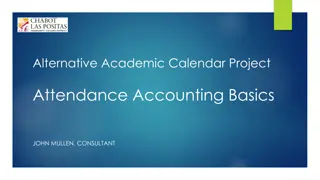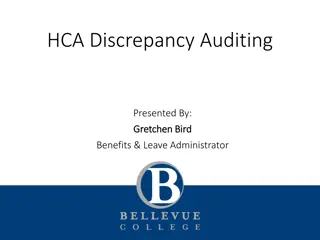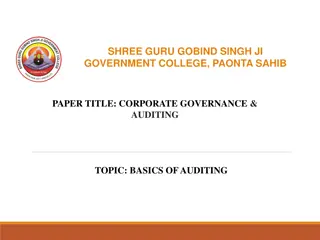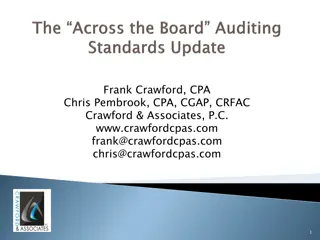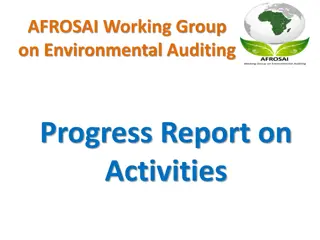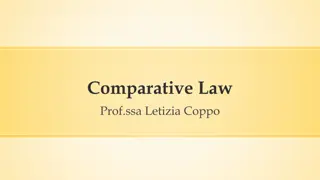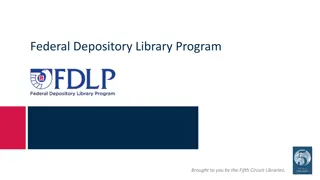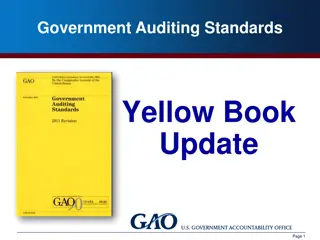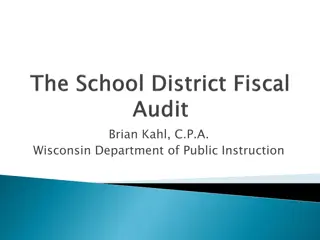Federal Government Accounting and Auditing Conference Update
CliftonLarsonAllen presents the Federal Government Accounting and Auditing Conference update, discussing topics such as fiscal sustainability, fiscal projections, social insurance, and standards-setting over the past 25 years. The event highlights important projects related to risk, assumed leases, public-private partnerships, and more.
Download Presentation

Please find below an Image/Link to download the presentation.
The content on the website is provided AS IS for your information and personal use only. It may not be sold, licensed, or shared on other websites without obtaining consent from the author.If you encounter any issues during the download, it is possible that the publisher has removed the file from their server.
You are allowed to download the files provided on this website for personal or commercial use, subject to the condition that they are used lawfully. All files are the property of their respective owners.
The content on the website is provided AS IS for your information and personal use only. It may not be sold, licensed, or shared on other websites without obtaining consent from the author.
E N D
Presentation Transcript
CliftonLarsonAllen Federal Government Accounting and Auditing Conference FASAB Update Wendy Payne, CPA, CGFM Tuesday, January 20, 2015 1
Disclaimer Views expressed are those of the speaker. The Board expresses its views in official publications. 2
OVERVIEW 25 Years Fiscal Sustainability Our Annual Report and Three-Year Plan Federal Reporting Entity Review of Current Projects: Reporting Model Risk Assumed Leases Public-Private Partnerships Department of Defense 3
legislators generally considered management reform about as exciting as sorting cranberries Michael D. Serlin, Born-again financial management. Government Executive (May 1996). Sustained Management Reform 4
Social Insurance Summary (in billions of $s) Participants who have attained eligibility age: Revenue Expenditures for scheduled benefits 2013 $ 2,101 (18,175) Present value of future expenditures in excess of future revenue (16,074) Participants who have not attained eligibility age: Revenue Expenditures for scheduled benefits 38,362 (76,262) Present value of future expenditures in excess of future revenue (37,900) (53,974) Closed Group - Total present value of future expenditures in excess of future revenue Future participants: Revenue Expenditures for scheduled benefits 32,851 (18,575) Present value of future expenditures in excess of future revenue 14,276 $ (39,698) Open Group - Total present value of future expenditures in excess of future revenue Source: Financial Report of the US Government FY2013 7
Long-Term Fiscal Projections 2013 Dollars in Trillions % of GDP Receipts: Social Security Payroll Taxes Medicare Payroll Taxes Individual Income Taxes Other Receipts Total Receipts 46.1 15.4 113.2 41.5 216.2 4.2 1.4 10.4 3.9 19.7 Non-interest Spending: Social Security Medicare Part A Medicare Parts B & D Medicaid Defense Discretionary Non-defense Discretionary Other Mandatory Total Non-interest Spending 62.4 23.5 24.4 25.2 23.1 27.5 34.0 220.2 5.7 2.2 2.2 2.3 2.1 2.5 3.1 20.2 4.0 0.4 Non-interest Spending less Receipts 1.7 Fiscal Gap as a percent of GDP Source: Financial Report of the US Government FY2013 8
FEDERAL ACCOUNTING STANDARDS ADVISORY BOARD Annual Report Fiscal Year Ended September 30, 2014 Three-Year Plan Fiscal Years 2015-2017 Comments Requested by January 31, 2015 9
FASAB Annual Report Beginning in 2010 FASAB was asked to issue an annual report to facilitate oversight. http://www.fasab.gov/about/our-annual-reports/ Provides: A progress update Member feedback on continued conformance to the criteria for a GAAP-standards setting body Combined with our Three-year plan. 10
Three-Year Plan We need your input! 11
Research Project Tax Expenditures Tax provisions obscure & complex Decisions on tax expenditures are not made annually so the performance of tax provisions is not monitored. What provisions are like foregone revenue ? Equivalent to spending?
Research Project - Reconciling Budget and Accrual Information Government-wide Reconciliation: Net Cost to the Surplus(Deficit) Component Entity Reconciliation: Net Cost to Obligations Incurred and Other Resources 13
Other Potential Projects Electronic Reporting Asset Retirement Obligations Intangibles Revenue Summary or Popular Reporting Research and Development
Federal Reporting Entity SFFAS 47 (effective FY2018) Include in General Purpose Federal Financial Reports (GPFFR) all organizations: budgeted for, controlled with potential for risk or reward, or owned Does not specifically address particular entities. Provides for judgment about: Inclusion Classification Disclosure 15
Federal Reporting Entity (CONT.) Distinguish between consolidation entities and disclosure organizations Consolidation entities are: supported by general taxes, and on-going decision making, and are more clearly linked to elected officials. Information for consolidation entities is to be consolidated in financial statements. 16
Federal Reporting Entity (CONT.) Disclosure organizations are: somewhat independent from elected officials, and may be financially self-sustaining. Information regarding such organizations is to be disclosed in notes with an emphasis on risk. 17
Federal Reporting Entity (CONT.) Also addresses: What entities are subject to SFFAS 34 the GAAP hierarchy for federal entities What organizations to include in component reporting entity GPFFR How to deal with: FASB-basis information for consolidation entities Different year ends for disclosure organizations Related parties Amendments to SFFAC 2, Entity and Display 18
Reporting Model Seeking to enhance the benefits of accrual basis financial statements Input to the Board: User needs surveys, focus groups, and roundtables FASAB Task Force on Government-wide Financial Reports (Dec 2010) CFO Act 20-Year Report Input from task forces focusing on agency level reporting on cost, budget and performance Statement of spending pilots Study of other sovereign government practices 20
Reporting Model (cont.) Research Results Participants want particular or specialized information to meet their needs: Understandability of financial information Centralized source for obtaining data Move toward real-time data Address program managers needs Integrated data Financial and non-financial performance information Program level cost information Add forward-looking information in agency reports 21
Reporting Model (cont.) Research Results Improvement Needed in the Statement of Net Cost: Now - cost by strategic goal Some prefer to focus on cost by organizations, programs, or projects Matching cost and output (and eventually outcome) is not so easy! Same terms used differently by different disciplines (cost per the budget versus cost per accrual principles versus cost per program evaluators) 22
RISK ASSUMED Current Standards are limited to insurance contracts and explicit guarantees (other than loan guarantees). When implementing policy initiatives to stabilize financial markets and the economy, the federal government explicitly assumed risks previously considered by some to have implied backing of the federal government. In order to meet the stewardship and operating performance objectives of federal financial reporting It is important that the federal government report all significant risks assumed, not just risks related to insurance contracts and explicit guarantees. 23
RISK ASSUMED (cont.) - Three Phases - Phase I: Insurance and [Non-Loan] Guarantees Phase II: Entitlement Programs, including: National Defense, Security and Disaster response Other potential effects on future outflows: regulatory actions, Government Sponsored Enterprises (GSEs), etc. Phase III: Commitments Obligations Other risk areas 24
RISK ASSUMED (cont.) - Insurance & Guarantee Phase - Define federal Insurance and [Non-Loan] Guarantee programs Improve terminology ( premium deficiency and subsidy ) Address measurement uncertainty Disclose risk assumed 25
Leases Are all leases financings? 26
Leases (cont.) FASAB is partnering with GASB to develop standards for governmental organizations. Tentative decision to establish a single model (with exceptions for short-term arrangements). Leases create assets consisting of the right to use a resource. Leases create liabilities consisting of the obligation to pay for the resource. The focus may be on the interest cost associated with leases. 27
Public-Private Partnerships Due to budget pressures, federal agencies have increasingly turned to public-private partnerships (e.g., PPPs, P3s) to accomplish goals Transparency of the full costs and risks of such partnerships is the overall objective Specific objectives include: Defining terms (e.g., service concession arrangements, P3s) Providing guidance for the recognition and measurement of: assets and liabilities revenues and expenses risks Consider implications for other arrangements related to P3s (sale- leaseback or other long-term arrangements). 28
DoD Implementation Guidance SFFAS 3 Are estimates for inventory and related property permitted? Research and development when is it capitalizable? Internal Use Software 29
Questions? 30
Contact and Website Information General inquiries can be directed to fasab@fasab.gov Phone: 202 512-7350 www.FASAB.gov Listserv (sign up for emails) Exposure Drafts Active Projects assigned staff My contact info: paynew@fasab.gov (202) 512-7357 31



